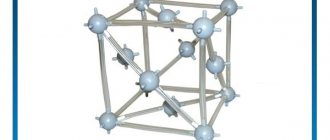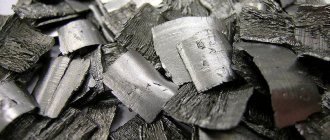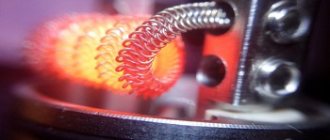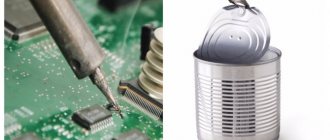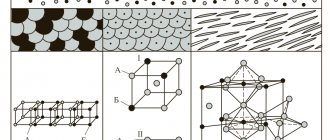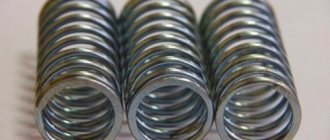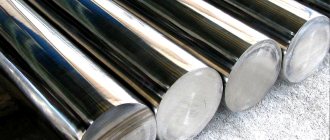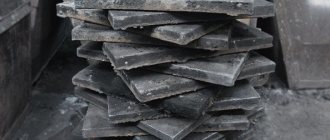In 1841, the world learned about an anti-friction alloy with the strange name Babbitt. It was created by jeweler Isaac Babbitt, who in his free time was fond of searching for new types of materials. This discovery was a turning point not only for the inventor, but also for the production of bearings. Bearings made from babbitt were distinguished by increased peripheral speeds, which made it possible to significantly increase the load transmitted by the shaft.
So what is this alloy? Why has the relevance of its application not changed so many years after its discovery?
Description
Babbitt B16 is used : for the production of pigs used for filling bearings and other parts; motor-axial bearings of electric locomotives, track machines, parts of steam locomotives and other heavy engineering equipment (bearings of gear stands of rolling mills, crushers, ball and pipe mills); in engine building and metallurgical engineering (for filling support bearings of steam turbines, ship and stationary steam engines with a power of up to 1200 hp, locomotives, hydraulic turbines, electric locomotives, electric motors with a power of up to 270 kW, generators with a power of up to 500 kW, compressors with a power of up to 500 hp, lifting machines with power up to 1800 hp.
Note
At room temperature, babbitt is brittle and cracks and chips in bearings under shock loads. The babbitt friction coefficient without lubrication is 0.25, with lubrication - 0.006. The maximum permissible rotation speed is 6 m/sec. Maximum permissible load: static - 150 kgf/cm2, dynamic - 500 kgf/cm2 sec. The maximum temperature for normal bearing operation is +110 °C. Recommended pouring thickness ≥1.00 mm.
Types of babbitts and their properties
Among the features of babbitts are a low melting point (up to 450 ºС), lack of adhesion to steel surfaces and high workability.
Depending on the chemical composition, babbits are divided into 3 groups: lead, tin and lead-calcium.
Tin
There are about 35 grades of tin in the industry, but the most widely used is Babbitt B83. Its composition is based on tin with the addition of 12% antimony and 6.5% copper. Less than 1% consists of harmful impurities such as phosphorus, sulfur, oxygen, zinc, iron and aluminum. The reason they end up in babbitt is the imperfection of smelting technology and the inaccuracy of the chemical composition of the alloys.
The density of tin babbitt is 7380 kg/m3. It has a low hardness value of 28-30 units on the Brinell scale. Moreover, compared to other antifriction alloys, Babbitt B83 has the highest ductility index. The relative tensile elongation is 36-40%.
The tensile strength ranges from 9-10 kg/cm2, which is almost 4.5 times less than that of structural steels. The voltage at which the babbitt begins to “flow” (deform without increasing the load) is 7 kg/cm2.
Babbitt B83 begins to melt at a temperature of 240 ºС. Complete transition to the liquid phase occurs at 350 ºС. The temperature at which it is recommended to pour the alloy into the mold is 450 ºС.
The tin content of Babbitt B83 makes it insensitive to weak acids and alkalis. Babbitt does not oxidize in air and is resistant to aquatic environments.
B83 is used exclusively for filling bearings of machines of significant power, where a high viscosity value and the lowest friction coefficients are required. Such bearings allow achieving high peripheral speeds of up to 50 m/s. The optimal operating temperature is 75 ºС. The coefficient of friction with lubricant between babbitt and steel is 0.005 units. All this allows the bearing to withstand loads of over 100 kg/cm2.
These types of bearings are used in steam turbines, turbochargers, diesel engines, electric motors and other mechanical engineering products.
Leaded
The most popular lead brand is B16. Its chemical composition consists of 15% tin, 15% antimony, 2% copper. The remaining part is occupied by lead.
Lead babbits have lower anti-friction characteristics, are more fragile and wear-resistant. An increase in the content of antimony and tin in B16 increases the strength properties, but negatively affects its ductility. Copper in this grade eliminates chemical heterogeneity, increases viscosity and slightly increases hardness.
The increased lead content in Babbitt B16 makes it more dense. Density is 9290 kg/m3. Hardness is about 30 units on the Brinell scale. The tensile strength is 8 kg/cm2. Deformation processes begin already at a load of 6 kg/cm2.
Babbitt B16 melts at a temperature of 410 ºС. Complete melting of all solid components of the alloy occurs at 480 ºС.
B16 is fragile. For this reason, its use is limited to impact loads. Bearings based on it are used during quiet operation and at peripheral speeds of up to 120 m/s. The ambient temperature should not exceed 70 ºС. The friction coefficient of B16 is 0.006 units.
Bearings made from B16 are used in the manufacture of turbines for steam plants, rolling mills, compressors, electric motors, hydraulic turbines and sawmill frames.
Lead-calcium
Babbitt BKA has received the greatest use for the manufacture of bearings. In addition to lead, it contains elements such as calcium (up to 1.2%), sodium (up to 0.9%) and aluminum (up to 0.2%). Antifriction properties are ensured by the presence of the lead calcite compound in the alloy structure. Their role is similar to tin in B83. Sodium increases the mechanical characteristics of BKA, in particular hardness. The aluminum content of babbitt has a positive effect on both strength and friction coefficient.
The mechanical properties of BKA are increased by heat treatment: natural aging. This process is accelerated by additional heating to 60 ºС.
Babbitt does not adhere to the steel and is held on its surface by mechanical fastening. The operating temperature of bearings based on lead-calcium babbits is 60 ºС. As the operating temperature increases, the hardness of the babbitt greatly decreases, which can lead to destruction of the bearing rings.
These bearings have a low price due to the replacement of expensive tin with cheaper metals. But their disadvantage lies in their strength and low corrosion-resistant properties, which lead to oxidation of babbitt in air, and, as a result, a sharp decrease in wear resistance. For this reason, the main application of BKA Babbitt bearings is in railway production, which does not have significant requirements for both load and peripheral speeds.
Chemical composition
| Standard | Fe | Cu | As | Al | Zn | Sn | Sb | Pb | Bi |
| GOST 1320-74 (ISO 4383-91 | ≤0.08 | 1.5-2 | ≤0.2 | ≤0.01 | ≤0.07 | 15-17 | 15-17 | Remainder | ≤0.1 |
| OST 24.916.01-71 | ≤0.1 | 1.5-2 | ≤0.3 | — | ≤0.15 | 15-17 | 15-17 | Remainder | ≤0.1 |
| STP M320-74 | ≤0.1 | 1.5-2 | ≤0.3 | ≤0.01 | ≤0.15 | 15-17 | 15-17 | Remainder | ≤0.1 |
Pb is the base. The total content of impurities according to OST 24.916.01-71 should be ≤ 0.60%. The presence of cadmium up to 0.10% and nickel up to 0.50% is allowed. The tin content according to OST 24.916.01-71, STP M320-74 and STP M320-2003 should not exceed the antimony content.
Production
Both ore and scrap metal are used to smelt babbitts. The share of secondary production in our country accounts for about 75%. Alloys are transported in the form of pigs, the weight of which is strictly regulated by state standards and does not exceed 22 kg.
Melting of pigs is carried out in special chamber-type electric furnaces. This process is relatively cheap. This is primarily due to the low melting point of the alloys. Typically, in medium-scale production conditions, 26 kW of furnace power is sufficient.
When melting, the main difficulty is obtaining the chemical composition stated in the state standard. Any deviation from the norm can lead to a significant change in performance characteristics, which will affect the longevity of the bearing in the future.
For this reason, pigs are pre-cleaned from contamination with special detergents. Next comes degreasing the surface. And only after all these steps have been completed is the babbitt placed in the oven.
Babbitt cost
Let's consider the cost of this alloy in the Russian Federation. The price directly depends on the properties of babbitt and its brand. Thus, the average price of lead babbit B16 is about 350 thousand rubles/ton. The cost of B83 alloy is about 1.3 million rubles/ton.
If we consider the market for recyclable materials, then 1 kg of babbitt scrap metal can be sold for a maximum price of 500-600 rubles/kg. Basically, such alloys are purchased for their subsequent disposal, because unnecessary bearings can cause irreparable harm to the environment, since cadmium, lead, and antimony are literally poisons for the nature around us.
View gallery
Babbitt alloys are far from a modern invention. However, they are still relevant in mechanics today, namely in the production of bearings. This is observed due to the fact that babbits are durable, wear-resistant, quickly and tightly rubbed into the part, ensure noiselessness during friction and, due to their low thermal conductivity, eliminate engine overheating. In addition, manufacturers offer dozens of different brands of babbitts, each of which corresponds to a specific type of both the bearing and the entire engine of the machine.
Viewpoint of the generally accepted standard for babbitt scrap
Waste compounds established by GOST 1639-2009 fall under the categories of secondary tin and its alloys:
- Lump babbitt scrap. The category contains exclusively tin alloy grades. Main components of recycled metal: diesel and turbine bearings.
- Lump waste with high lead content. Standard scrap bearings are complemented by used typographic elements.
- Shavings of tin-lead alloys. This group includes only tin babbit processing waste.
- Mixed shavings. It presents brands of lead compound variations.
Naturally, the main material value among babbitt scrap is represented by its varieties with a high tin content. The cost per kilogram of such scrap is close to the price of pure metal.
Due to the variety of alloy grades, as well as the impossibility of visually distinguishing different types of babbitt, spectral analysis is often used. Reception points for non-ferrous scrap metal, equipped with special analytical equipment, make it possible to accurately determine the concentration of tin, which can have a positive effect on the final price of accepted babbitt scrap.
Babbitt Specific Gravity Table
Since babbitt is a complex material, it is not possible to independently calculate its specific gravity in the field. These calculations are carried out in special chemical laboratories. However, the average specific gravity of babbitt is known and is equal to 7.3 to 10.1 g/cm3.
To simplify the calculations, below is a table with the values of the specific gravity of babbitt, as well as such a parameter as the weight of babbitt, depending on the units of calculation.
Specific gravity and weight of 1 m3 of babbitt depending on units of measurement
| Material | Specific gravity (g/cm3) | Weight 1 m3 (kg) |
| Babbitt | From 7.3 to 10.1 | From 7300 to 10100 |
Advantages and disadvantages
The advantages of this alloy, in addition to the low coefficient of friction and wear resistance, also include low fusibility. The melting point of babbitt is only 240 °C. Also the advantages of this metal are:
- the ability to withstand not only rotational, but also reciprocating movements;
- corrosion resistance;
- high degree of thermal conductivity;
- increased softening at temperatures above 100 C;
- high degree of impact strength.
It has Babbitt filling of the internal parts of the bearings and another advantage. In this metal, among other things, microchannels are formed through which lubricant is supplied to the rubbing elements.
This alloy has practically no disadvantages. However, it still has one rather serious drawback. Unfortunately, babbitt is a metal that is not particularly durable. That is why bearings are not entirely made from it. The body of these elements is made of stronger metals - most often steel.
general characteristics
In the periodic table of elements of D.I. Mendeleev, Ti is located in group IV of the 4th period at number 22. In the most important and most stable compounds, the metal is tetravalent. In appearance it resembles steel. Very common in nature. Its content in the earth's crust is higher than copper, lead and zinc.
The relative molecular mass of a substance shows how many times the mass of a given molecule is greater than 1/12 the mass of a carbon atom, and the relative atomic mass of an element is how many times the average mass of atoms of a chemical element is greater than 1/12 the mass of a carbon atom. Titanium in the free state exists in the form of monatomic Ti molecules. The values of its atomic and molecular masses coincide. They are equal to 47.867.
The main mechanical properties of titanium alloys include:
- Resistance to corrosive processes. This property is superior to steel. Does not corrode in air, sea water, wet chlorine and other technological solutions and reagents, so the material is indispensable in the chemical, pulp and paper, and oil industries.
- Lightness. It is in demand where a very light substance is needed that can withstand heavy loads and ultra-high temperature ranges - aircraft and rocket production.
- High specific strength. The indicator is approximately 2 times higher than iron and 6 times higher than aluminum. The tensile strength is 300–450 MPa, but it can be increased to 2,000 MPa through hardening, aging and the addition of certain elements. At the same time, the material retains its strength characteristics even when exposed to low temperatures.
- Paramagneticity. It is not magnetized in a magnetic field, but is not pushed out of it either.
- Low thermal conductivity. At room temperature the average is - 18 W/(m deg). As it warms up, the indicator increases. Thermal expansion is 3 times less than iron and 12 times less than aluminum.
- Satisfactory technological ductility of some alloys. In a hot state, various semi-finished products are obtained - sheets, rods, stampings, profiles, etc. At the same time, mechanical processing causes many difficulties.
Thus, the metal combines strength and ductility well, but most mechanical properties are determined by the content of impurities. Polymorphic transformations have a decisive role in the formation of structure. This plays an important role in the heat treatment of parts in accordance with the requirements of the drawing.
Equipment
What equipment is used to fill bearings with babbitt? For this purpose, special sets of equipment are produced, for example, KO-2, on which bearings are manufactured by centrifugal casting.
This kit is available in several modifications:
- MPS - for filling plain bearings 8ТН.263.028 and 8ТН.263.029;
- D360 x L310 - for pouring plain bearings with an outer diameter of up to 360 mm, an inner diameter of 40 mm and a length of up to 310 mm;
- D950 x L500 - for pouring plain bearings with an outer diameter of up to 950 mm, an inner diameter of 60 mm and a length of 500 mm.
The use of special equipment allows you to pour babbitt more accurately, without overuse and defects.
Read also: Measuring motor insulation resistance with a megohmmeter
For smelting babbitt from old bearing shells, special furnaces are also produced, for example, chamber furnaces of the PKN type of different sizes and power:
- PKN-0.6-2000 with a power of 100 kW,
- PKN-0.6-180 with a power of 26 kW.
The ovens are made of fire-resistant materials, and spirals of superfechral wire are used as heaters. They are equipped with a tray for installing bearing shells and a tray for draining molten babbitt.
Other types of furnaces are also used to pour the alloy into bearing shells, for example, PPN with a bottom spill valve. Crucibles with babbitt are placed in such furnaces. They are also heated by electric heaters. Such furnaces have a channel for emergency drainage and are controlled from a remote control on which operating modes are set. Ovens of the PPN type make it possible to dose babbitt into bearing shells.
